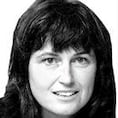THERE IS a pleasing irony in noting that Gustav Klimt, the Austrian painter and great innovator in the battle between reality and illusion, sex and death, was born 150 years ago on Saturday, a date more widely celebrated as the anniversary of the Fall of the Bastille.
Most often depicted in a photograph wearing his famous artist’s smock and holding a cat, the balding Klimt is seen good naturedly looking into the camera. He never painted a self-portrait, nor did he keep a diary; and he left very few papers. He was a revolutionary, the visual arts equivalent of his fellow Viennese Mahler and Schoenberg; and by temperament and inclination Klimt was well paced to record what would become known as the age of the erotic.
Anyone visiting Vienna will find it most difficult to avoid representations of The Kiss (1907/8), its slightly Oriental, somewhat Byzantine art nouveau style appears everywhere – from coffee tins to T-shirts to fridge magnets, and most probably on the shopping bag carrying those items. Although very well known, it is not really true to Klimt, as he painted femmes fatales, not passive females. Many of his subjects were society ladies. His Judith (1901) depicts a knowing courtesan of formidable self-possession.
Sex undercuts many of his portraits, yet never with the dark, doomed pathological despair favoured of his tormented younger associate Egon Schiele. Although in the allegorical Death and Life (1916) Klimt created one of most profound images in modern art, it could well summarise the abiding preoccupation of the modernist writers who emerged during this midpoint of the first World War.
Art was Klimt’s destiny. Born in Baumgarten, near Vienna, in 1862, he was the second child of a gold engraver’s seven children. From his earliest years he was well schooled in the traditional methods and techniques: this grounding gave him the confidence to experiment. By 14 he was already studying at the School of Applied Art in Vienna. He was to study historical painting and was also to become an assistant in Hans Makart’s studio. Later he would complete a commission for Makart, who died aged 44.
Klimt became a full-time artist and worked with his younger brother, who died in 1892, the same year as their father. As early as 1888 Gustav Klimt had received the Golden Order of Merit from Franz Josef, for theatre murals despite mutterings about his eroticism.
Less than a decade later he was elected president of the Secession, a group of artists intent on change as a statement rather than any specific new style. Klimt’s philosophy of art may be expressed by his Beethoven Frieze (1902) a 24m-long art nouveau work commissioned as part of a celebration of the composer and based on the Ninth Symphony. Executed in three parts, Yearning for Happiness, Hostile Forces and Hymn to Joy, it was seen by Klimt as a symbolic transposition of the symphony. It pleased some viewers, such as Rodin and outraged others.
By nature sociable, Klimt was always surrounded by friends and made no secret of his love of the Austrian countryside. He liked his garden to be wild and romantic. There was a priest-like quality about him, he was a genial mystic with a love of life, women adored him and he had many affairs. He is believed to have fathered at least 14 children by various lovers. Yet Emilie Flöge remained his companion, her loyalty was absolute, but it is not clear if their relationship was physical.
Klimt worked very slowly. His erotic work, with its distinctive use of gold paint, tends to overshadow the far more interesting landscape pictures which are clearly influenced by Van Gogh. Yet Klimt brings his own genius to these works which are often daringly original, even dream-like. Pictures such as Secluded Pond (1884), A Morning by the Pond (1899), The Swamp (1900), The Birch Forest (1903) convey his love of nature. His landscapes and atmospheric paintings of farmhouses and orchards are very different from his portraits depicting sitters in elaborately bejewelled gowns. They appear the work of two very different artists, which in ways they are. Many of Klimt’s landscapes are in private collections and it is easy to see why; they are very appealing, but that is not to diminish their worth.
On abandoning his gold period, Klimt returned to a somewhat more muted palette. Yet colour remained vital to him. His use of the art nouveau was his route towards expressionism. All too often Klimt’s landscapes are described as merely decorative. Yet they say so much more by deliberately confining themselves to the Earth. He does not engage the gods – there are no vast skies. Instead he looks to trees and flowers, the ground itself, rarely introducing shadows or light. These landscapes are meditation without prayer; nature without God.
In Farmhouse in Upper Austria (1911) the subject is both framed, and even more significantly, dwarfed by the trees. Admittedly in Schönbrunn Park (1916) he does allow the light to linger on the lake.
As recently as last November one of the Attersee series (1912-1916) sold for $40,000.
To the strange and unhappy young Egon Schiele, a station master’s son, who had to struggle against everything to become an artist, Klimt was a god, albeit one for whom it had all been much easier. Having been born into an artistic family, Klimt’s subsequent career appeared to be a natural extension of his life. Klimt had been 28 when Schiele was born and the younger man would die at that age, in October 1918, only months after Klimt died on February 6th, felled by a stroke, following complications from pneumonia contracted during the Spanish flu epidemic. He was only 55.
